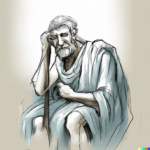
In the Book of Jeremiah, we can see shadows and types of Jesus Christ through prophecies, themes, and the experiences of Jeremiah that point forward to the Messiah. Here’s how we can see Jesus in the Book of Jeremiah:
1. Righteous Branch:
Jeremiah 23:5-6 prophesies about a coming “Righteous Branch,” a King from the line of David who will execute justice and righteousness. This is fulfilled in Jesus, the descendant of David, who brings God’s righteous rule (Luke 1:32-33).
2. New Covenant:
Jeremiah 31:31-34 foretells the establishment of a New Covenant, not like the one given to the ancestors. Jesus inaugurates this New Covenant through His blood, offering forgiveness of sins (Luke 22:20; Hebrews 8:6-13).
3. Suffering Servant:
Jeremiah’s sufferings and rejections prefigure the sufferings and rejections that Jesus would endure. Jeremiah was rejected by his own people, plotted against, and ridiculed, much like Jesus was (Jeremiah 11:18-21; Matthew 26:3-4; 27:31).
4. Weeping Prophet:
Jeremiah, known as the “weeping prophet” for his tears over Jerusalem’s impending destruction (Jeremiah 9:1), foreshadows Jesus, who wept over Jerusalem’s future fate (Luke 19:41-44).
5. The Potter and the Clay:
Jeremiah 18:1-6 describes God as the potter and Israel as the clay, emphasizing God’s sovereignty in shaping destinies. This analogy is reminiscent of Jesus as the divine potter who reshapes and reforms our lives (Romans 9:20-21).
6. Living Water:
Jeremiah condemns Israel for forsaking God, the “fountain of living waters” (Jeremiah 2:13). Jesus refers to Himself as the source of “living water,” offering eternal life (John 4:10-14; 7:37-38).
7. Good Shepherd:
Jeremiah foretells the coming of shepherds who will care for God’s flock (Jeremiah 3:15), which is fulfilled in Jesus, the Good Shepherd who lays down His life for the sheep (John 10:11).
8. Called Before Birth:
Jeremiah’s calling before he was formed in the womb (Jeremiah 1:5) foreshadows the divine calling and mission of Jesus, foreordained before the foundation of the world (1 Peter 1:20).
9. Redemption and Restoration:
The themes of judgment and subsequent restoration in Jeremiah echo the redemptive work of Jesus. Jesus, through His death and resurrection, brings redemption and the hope of eternal restoration (Colossians 1:13-14; Revelation 21:1-5).
Conclusion:
While Jeremiah himself is not Jesus, the themes, prophecies, and experiences within the Book of Jeremiah point toward the coming Messiah, Jesus Christ, and His mission to bring redemption, establish a new covenant, and shepherd God’s people. These connections underscore the unity of Scripture and its culmination in the person and work of Jesus.
